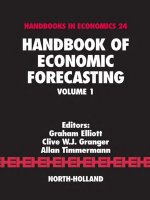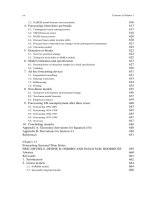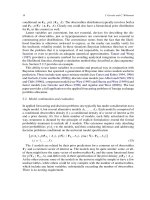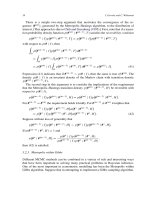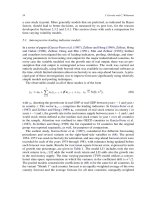Handbook of Economic Forecasting part 84 docx
Bạn đang xem bản rút gọn của tài liệu. Xem và tải ngay bản đầy đủ của tài liệu tại đây (149.72 KB, 10 trang )
804 T.G. Andersen et al.
it follows readily that
(3.12)σ
2
t+h|t
= σ
2
+ (α + 0.5γ + β)
h−1
σ
2
t+1|t
− σ
2
,
where the long-run, or unconditional variance, now equals
(3.13)σ
2
= ω(1 − α − 0.5γ − β)
−1
.
Although the forecasting formula looks almostidenticaltothe one for the GARCH(1, 1)
model in Equation (3.9), the inclusion of the asymmetric term may materially affect the
forecasts by importantly altering the value of the current conditional variance, σ
2
t+1|t
.
The news impact curve, defined by the functional relationship between σ
2
t|t−1
and
ε
t−1
holding all other variables constant, provides a simple way of characterizing the
influence of the most recent shock on next periods conditional variance. In the standard
GARCH model this curve is obviously quadratic around ε
t−1
= 0, while the GJR model
with γ>0 has steeper slopes for negative values of ε
t−1
. In contrast, the Asymmetric
GARCH, or AGARCH(1, 1), model,
(3.14)σ
2
t|t−1
= ω + α(ε
t−1
− γ)
2
+ βσ
2
t−1|t−2
,
shifts the center of the news impact curve from zero to γ , affording an alternative way
of capturing asymmetric effects. The GJR and AGARCH model may also be combined
to achieve even more flexible parametric formulations.
Instead of directly parameterizing the conditional variance, the EGARCH model
is formulated in terms of the logarithm of the conditional variance, as in the
EGARCH(1, 1) model,
(3.15)log
σ
2
t|t−1
= ω + α
|z
t−1
|−E
|z
t−1
|
+ γz
t−1
+ β log
σ
2
t−1|t−2
,
where as previously defined, z
t
≡ σ
−1
t|t−1
ε
t
. As for the GARCH model, the EGARCH
model is readily extended to higher order models by including additional lags on the
right-hand side. The parameterization in terms of logarithms has the obvious advan-
tage of avoiding nonnegativity constraints on the parameters, as the variance implied
by the exponentiated logarithmic variance from the model is guaranteed to be posi-
tive. As in the GJR and AGARCH models above, values of γ>0intheEGARCH
model directly captures the asymmetric response, or “leverage” effect. Meanwhile, be-
cause of the nondifferentiability with respect to z
t−1
at zero, the EGARCH model is
often somewhat more difficult to estimate and analyze numerically. From a forecast-
ing perspective, the recursions defined by the EGARCH equation (3.15) readily deliver
the optimal – in a mean-square error sense – forecast for the future logarithmic condi-
tional variances, E(log(σ
2
t+h
) | F
t
). However, in most applications the interest centers
on point forecasts for σ
2
t+h
, as opposed to log(σ
2
t+h
). Unfortunately, the transforma-
tion of the E(log(σ
2
t+h
) | F
t
) forecasts to E(σ
2
t+h
| F
t
) generally depends on the
entire h-step ahead forecast distribution, f(y
t+h
| F
t
). As discussed further in Sec-
tion 3.6 below, this distribution is generally not available in closed-form, but it may
Ch. 15: Volatility and Correlation Forecasting 805
be approximated by Monte Carlo simulations from the convolution of the correspond-
ing h one-step-ahead predictive distributions implied by the z
t
innovation process using
numerical techniques. In contrast, the expression for σ
2
t+h|t
in Equation (3.12) for the
GJR or TGARCH model is straightforward to implement, and only depends upon the
assumption that P(z
t
< 0) = 0.5.
3.4. Long memory and component structures
The GARCH, TGARCH, AGARCH, and EGARCH models discussed in the previous
sections all imply that shocks to the volatility decay at an exponential rate. To illustrate,
consider the GARCH(1, 1) model. It follows readily from Equation (3.9) that the im-
pulse effect of a time-t shock on the forecast of the variance h period into the future is
given by ∂σ
2
t+h|t
/∂ε
2
t
= α(α + β)
h−1
, or more generally
(3.16)∂σ
2
t+h|t
/∂ε
2
t
= κδ
h
,
where 0 <δ<1. This exponential decay typically works well when forecasting over
short horizons. However, numerous studies, including Ding, Granger and Engle (1993)
and Andersen and Bollerslev (1997), have argued that the autocorrelations of squared
and absolute returns decay at a much slower hyperbolic rate over longer lags. In the
context of volatility forecasting using GARCH models parameterized in terms of ε
2
t
,this
suggests that better long term forecasts may be obtained by formulating the conditional
variance in such a way that the impulse effect behaves as
(3.17)∂σ
2
t+h|t
/∂ε
2
t
≈ κh
δ
,
for large values of h, where again 0 <δ<1. Several competing long-memory, or
fractionally integrated, GARCH type models have been suggested in the literature to
achieve this goal.
In the Fractionally Integrated FIGARCH(1,d,1) model proposed by Baillie, Boller-
slev and Mikkelsen (1996) the conditional variance is defined by
(3.18)σ
2
t|t−1
= ω + βσ
2
t−1|t−2
+
1 − βL −(1 − αL − βL)(1 − L)
d
ε
2
t
.
For d = 0 the model reduces to the standard GARCH(1, 1) model, but for values of
0 <d<1 shocks to the point volatility forecasts from the model will decay at a slow
hyperbolic rate. The actual forecasts are most easily constructed by recursive substitu-
tion in
(3.19)σ
2
t+h|t+h−1
= ω(1 − β)
−1
+ λ(L)σ
2
t+h−1|t+h−2
,
with σ
2
t+h|t+h−1
≡ ε
2
t
for h<0, and the coefficients in λ(L) ≡ 1 − (1 − βL)
−1
(1 −
αL −βL)(1 − L)
d
calculated from the recursions,
λ
1
= α +d,
λ
j
= βλ
j−1
+
(j − 1 −d)j
−1
− (α + β)
δ
j−1
,j= 2, 3, ,
806 T.G. Andersen et al.
where δ
j
≡ δ
j−1
(j −1−d)j
−1
refer to the coefficients in the MacLaurin series expan-
sion of the fractional differencing operator, (1 − L)
d
. Higher order FIGARCH models,
or volatility forecast filters, may be defined in an analogous fashion. Asymmetries are
also easily introduced into the recursions by allowing for separate influences of past
positive and negative innovations as in the GJR or TGARCH model. Fractional Inte-
grated EGARCH, or FIEGARCH, models may be similarly defined by parameterizing
the logarithmic conditional variance as a fractionally integrated distributed lag of past
values.
An alternative, and often simpler, approach for capturing longer-run dependencies
involves the use of component type structures. Granger (1980) first showed that the
superposition of an infinite number of stationary AR(1) processes may result in a true
long-memory process. In fact, there is a long history in statistics and time series econo-
metrics for approximating long memory by the sum of a few individually short-memory
components. This same idea has successfully been used in the context of volatility mod-
eling by Engle and Lee (1999) among others.
In order to motivate the Component GARCH model of Engle and Lee (1999), rewrite
the standard GARCH(1, 1) model in (3.6) as
(3.20)
σ
2
t|t−1
− σ
2
= α
ε
2
t−1
− σ
2
+ β
σ
2
t−1|t−2
− σ
2
,
where it is assumed that α + β<1, so that the model is covariance stationary and the
long term forecasts converge to the long-run, or unconditional, variance σ
2
= ω(1 −
α − β)
−1
. The component model then extends the basic GARCH model by explicitly
allowing the long-term level to be time-varying,
(3.21)
σ
2
t|t−1
− ζ
2
t
= α
ε
2
t−1
− ζ
2
t
+ β
σ
2
t−1|t−2
− ζ
2
t
,
with ζ
2
t
parameterized by the separate equation,
(3.22)ζ
2
t
= ω + ρζ
2
t−1
+ ϕ
ε
2
t−1
− σ
2
t−1|t−2
.
Hence, the transitory dynamics is governed by α + β, while the long-run dependencies
are described by ρ>0. It is possible to show that for the model to be covariance
stationary, and the unconditional variance to exist, the parameters must satisfy (α +
β)(1 − ρ) + ρ<1. Also, substituting the latter equation into the first, the model may
be expressed as the restricted GARCH(2, 2) model,
σ
2
t|t−1
= ω(1 − α − β) + (α + ϕ)ε
2
t−1
−
ϕ(α + β) +ρα
ε
2
t−2
+ (ρ +β +ϕ)σ
2
t−1|t−2
+
ϕ(α + β) −ρβ
σ
2
t−2|t−3
.
As for the GARCH(1, 1) model, volatility shocks therefore eventually dissipate at the
exponential rate in Equation (3.15). However, for intermediate forecast horizons and
values of ρ close to unity, the volatility forecasts from the component GARCH model
will display approximate long memory.
To illustrate, consider Figure 6 which graphs the volatility impulse response func-
tion, ∂σ
2
t+h|t
/∂ε
2
t
, h = 1, 2, ,250, for the RiskMetrics forecasts, the standard
Ch. 15: Volatility and Correlation Forecasting 807
Figure 6. Volatility impulse response coefficients. The left panel graphs the volatility impulse response func-
tion, ∂σ
2
t+h|t
/∂ε
2
t
, h = 1, 2, ,250, for the RiskMetrics forecasts, the standard GARCH(1, 1) model
in (3.6), the FIGARCH(1,d,1) model in (3.18), and the component GARCH model in (3.21) and (3.22).
The right panel plots the corresponding logarithmic values.
GARCH(1, 1) model in (3.6), the FIGARCH(1,d,1) model in (3.18), and the com-
ponent GARCH model defined by (3.21) and (3.22). The parameters for the different
GARCH models are calibrated to match the volatilities depicted in Figure 1. To facil-
itate comparisons and exaggerate the differences across models, the right-hand panel
depicts the logarithm of the same impulse response coefficients. The RiskMetrics fore-
casts, corresponding to an IGARCH(1, 1) model with α = 0.06, β = 1 − α = 0.94
and ω = 0, obviously results in infinitely persistent volatility shocks. In contrast, the
impulse response coefficients associated with the GARCH(1, 1) forecasts die out at the
exponential rate (0.085+0.881)
h
, as manifest by the log-linear relationship in the right-
hand panel. Although the component GARCH model also implies an exponential decay
and therefore a log-linear relationship, it fairly closely matches the hyperbolic decay
rate for the long-memory FIGARCH model for the first 125 steps. However, the two
models clearly behave differently for forecasts further into the future. Whether these
differences and potential gains in forecast accuracy over longer horizons are worth the
extra complications associated with the implementation of a fractional integrated model
obviously depends on the specific uses of the forecasts.
3.5. Parameter estimation
The values of the parameters in the GARCH models are, of course, not known in prac-
tice and will have to be estimated. By far the most commonly employed approach for
doing so is Maximum Likelihood Estimation (MLE) under the additional assumption
that the standardized innovations in Equation (3.5), z
t
≡ σ
−1
t|t−1
(y
t
− μ
t|t−1
), are i.i.d.
808 T.G. Andersen et al.
normally distributed, or equivalently that the conditional density for y
t
takes the form,
(3.23)f(y
t
| F
t−1
) = (2π)
−1/2
σ
−1
t|t−1
exp
−1/2σ
−2
t|t−1
(y
t
− μ
t|t−1
)
2
.
In particular, let θ denote the vector of unknown parameters entering the conditional
mean and variance functions to be estimated. By standard recursive conditioning argu-
ments, the log-likelihood function for the y
T
,y
T −1
, ,y
1
sample is then simply given
by the sum of the corresponding T logarithmic conditional densities,
log L(θ ;y
T
, ,y
1
)
(3.24)=−
T
2
log(2π) −
1
2
T
t=1
log σ
2
t|t−1
(θ) −σ
−2
t|t−1
(θ)
y
t
− μ
t|t−1
(θ)
2
.
The likelihood function obviously depends upon the parameters in a highly nonlinear
fashion, and numerical optimization techniques are required in order to find the value of
θ which maximizes the function, say
ˆ
θ
T
. Also, to start up the recursions for calculating
σ
2
t|t−1
(θ), pre-sample values of the conditional variances and squared innovations are
also generally required. If the model is stationary, these initial values may be fixed at
their unconditional sample counterparts, without affecting the asymptotic distribution
of the resulting estimates. Fortunately, there now exist numerous software packages for
estimating all of the different GARCH formulations discussed above based upon this
likelihood approach.
Importantly, provided that the model is correctly specified and satisfies a necessary
set of technical regularity conditions, the estimates obtained by maximizing the func-
tion in (3.24) inherit the usual optimality properties associated with MLE, allowing for
standard parameter inference based on an estimate of the corresponding information
matrix. This same asymptotic distribution may also be used in incorporating the para-
meter estimation error uncertainty in the distribution of the volatility forecasts from the
underlying model. However, this effect is typically ignored in practice, instead relying
on a simple plugin approach using
ˆ
θ
T
in place of the true unknown parameters in the
forecasting formulas. Of course, in many financial applications the size of the sample
used in the parameter estimation phase is often very large compared to the horizon of the
forecasts, so that the additional influence of the parameter estimation error is likely to be
relatively minor compared to the inherent uncertainty in the forecasts from the model.
Bayesian inference procedures can, of course, also be used in directly incorporating the
parameter estimation error uncertainty in the model forecasts.
More importantly from a practical perspective, the log-likelihood function in Equa-
tion (3.24) employed in almost all software packages is based on the assumption that
z
t
is i.i.d. normally distributed. Although this assumption coupled with time-varying
volatility implies that the unconditional distribution of y
t
has fatter tails than the normal,
this is typically not sufficient to account for all of the mass in the tails in the distributions
of daily or weekly returns. Hence, the likelihood function is formally misspecified.
However, if the conditional mean and variance are correctly specified, the corre-
sponding Quasi-Maximum Likelihood Estimates (QMLE) obtained under this auxiliary
Ch. 15: Volatility and Correlation Forecasting 809
assumption of conditional normality will generally be consistent for the true value of θ .
Moreover, asymptotically valid robust standard errors may be calculated from the so-
called “sandwich-form” of the covariance matrix estimator, defined by the outer product
of the gradients post- and pre-multiplied by the inverse of the usual information matrix
estimator. Since the expressions for the future conditional variances for most of the
GARCH models discussed above do not depend upon the actual distribution of z
t
,as
long as E(z
t
| F
t−1
) = 0 and E(z
2
t
| F
t−1
) = 1, this means that asymptotically valid
point volatility forecasts may be constructed from the conditionally normal QMLE for
θ without fully specifying the distribution of z
t
.
Still, the efficiency of the parameter estimates, and therefore the accuracy of the
resulting point volatility forecasts obtained by simply substituting
ˆ
θ
T
in place of the
unknown parameters in the forecasting formulas, may be improved by employing the
correct conditional distribution of z
t
. A standardized Student t distribution with degrees
of freedom ν>2 often provides a good approximation to this distribution. Specifically,
f(y
t
| F
t−1
) = Γ
ν + 1
2
Γ
ν
2
−1
(ν − 2)σ
2
t|t−1
−1/2
(3.25)×
1 + (ν −2)
−1
σ
−2
t|t−1
(y
t
− μ
t|t−1
)
2
−(ν+1)/2
with the log-likelihood function given by the sum of the corresponding T logarithmic
densities, and the degrees of freedom parameter ν estimated jointly with the other pa-
rameters of the model entering the conditional mean and variance functions. Note, that
for ν →∞the distribution converges to the conditional normal density in (3.23).Of
course, more flexible distributions allowing for both fat tails and asymmetries could
be, and have been, employed as well. Additionally, semi-nonparametric procedures in
which the parameters in μ
t|t−1
(θ) and σ
2
t|t−1
(θ) are estimated sequentially on the basis
of nonparametric kernel type estimates for the distribution of ˆz
t
have also been devel-
oped to enhance the efficiency of the parameter estimates relative to the conditionally
normal QMLEs. From a forecasting perspective, however, the main advantage of these
more complicated conditionally nonnormal estimation procedures lies not so much in
the enhanced efficiency of the plugin point volatility forecasts, σ
2
T +h|T
(
ˆ
θ
T
), but rather in
their ability to better approximate the tails in the corresponding predictive distributions,
f(y
T +h
| F
T
;
ˆ
θ
T
). We next turn to a discussion of this type of density forecasting.
3.6. Fat tails and multi-period forecast distributions
The ARCH class of models directly specifies the one-step-ahead conditional mean and
variance, μ
t|t−1
and σ
2
t|t−1
, as functions of the time t −1 information set, F
t−1
. As such,
the one-period-ahead predictive density for y
t
is directly determined by the distribution
of z
t
. In particular, assuming that z
t
is i.i.d. standard normal,
f
z
(z
t
) = (2π)
−1/2
exp(−z
i
/2),
810 T.G. Andersen et al.
the conditional density of y
t
is then given by the expression in Equation (3.23) above,
where the σ
−1
t|t−1
term is associated with the Jacobian of the transformation from z
t
to y
t
. Thus, in this situation, the one-period-ahead VaR at level p is readily calculated
by VaR
p
t+1|t
= μ
t+1|t
+ σ
t+1|t
F
−1
z
(p), where F
−1
z
(p) equals the pth quantile in the
standard normal distribution.
Meanwhile, as noted above the distributions of the standardized GARCH innovations
often have fatter tails than the normal distribution. To accommodate this feature alterna-
tive conditional error distributions, such as the Student t distribution in Equation (3.25)
discussed above, may be used in place of the normal density in Equation (3.23) in the
construction of empirically more realistic predictive densities. In the context of quantile
predictions, or VARs, this translates into multiplication factors, F
−1
z
(p), in excess of
those for the normal distribution for small values of p. Of course, the exact value of
F
−1
z
(p) will depend upon the specific parametric estimates for the distribution of z
t
.
Alternatively, the standardized in-sample residuals based on the simpler-to-implement
QMLE for the parameters, say ˆz
t
≡ˆσ
−1
t|t−1
(y
t
−ˆμ
t|t−1
), may be used in nonparametri-
cally estimating the distribution of z
t
, and in turn the quantiles,
ˆ
F
−1
z
(p).
The procedures discussed above generally work well in approximating VARs within
the main range of support of the distribution, say 0.01 <p<0.99. However, for
quantiles in the very far left or right tail, it is not possible to meaningfully estimate
F
−1
z
(p) without imposing some additional structure on the problem. Extreme Value
Theory (EVT) provides a framework for doing so. In particular, it follows from EVT
that under general conditions the tails of any admissible distribution must behave like
those of the Generalized Pareto class of distributions. Hence, provided that z
t
is i.i.d., the
extreme quantiles in f(y
t+1
| F
t
) may be inferred exactly as above, using only the [rT ]
smallest (largest) values of ˆz
t
in actually estimating the parameters of the corresponding
extreme value distribution used in calculating
ˆ
F
−1
z
(p). The fraction r of the full sample
T used in this estimation dictates where the tails, and consequently the extreme value
distribution, begin. In addition to standard MLE techniques, a number of simplified
procedures, including the popular Hill estimator, are also available for estimating the
required tail parameters.
The calculation of multi-period forecast distributions is more complicated. To facili-
tate the presentation, suppose that the information set defining the conditional one-step-
ahead distribution, f(y
t+1
| F
t
), and consequently the conditional mean and variance,
μ
t+1|t
and σ
2
t+1|t
, respectively, is restricted to current and past values of y
t
. The multi-
period-ahead predictive distribution is then formally defined by the convolution of the
corresponding h one-step-ahead distributions,
f(y
t+h
| F
t
) =
f(y
t+h
| F
t+h−1
)f (y
t+h−1
| F
t+h−2
)
(3.26) f(y
t+1
| F
t
) dy
t+h−1
dy
t+h−2
dy
t+1
.
This multi-period mixture distribution generally has fatter tails than the underlying one-
step-ahead distributions. In particular, assuming that the one-step-ahead distributions
are conditionally normal as in (3.23) then, if the limiting value exists, the unconditional
Ch. 15: Volatility and Correlation Forecasting 811
distribution, f(y
t
) = lim
h→∞
f(y
t
| F
t−h
), will be leptokurtic relative to the nor-
mal. This is, of course, entirely consistent with the unconditional distribution of most
speculative returns having fatter tails than the normal. It is also worth noting that even
though the conditional one-step-ahead predictive distributions, f(y
t+1
| F
t
), may be
symmetric, if the conditional variance depends on the past values of y
t
in an asym-
metric fashion, as in the GJR, AGARCH or EGARCH models, the multi-step-ahead
distribution, f(y
t+h
| F
t
), h>1, will generally be asymmetric. Again, this is directly
in line with the negative skewness observed in the unconditional distribution of most
equity index return series.
Despite these general results, analytical expressions for the multi-period predictive
density in (3.26) are not available in closed-form. However, numerical techniques may
be used in recursively building up an estimate for the predictive distribution, by re-
peatedly drawing future values for y
t+j
= μ
t+j|t+j −1
+ σ
t+j|t+j −1
z
t+j
based on the
assumed parametric distribution f
z
(z
t
), or by bootstrapping z
t+j
from the in-sample
distribution of the standardized residuals.
Alternatively, f(y
t+h
| F
t
) may be approximated by a time-invariant paramet-
ric or nonparametrically estimated distribution with conditional mean and variance,
μ
t+h|t
≡ E(y
t+j
| F
t
) and σ
2
t+h|t
≡ Var (y
t+j
| F
t
), respectively. The multi-step
conditional variance is readily calculated along the lines of the recursive prediction for-
mulas discussed in the preceding sections. This approach obviously neglects any higher
order dependencies implied by the convolution in (3.26). However, in contrast to the
common approach of scaling which, as illustrated in Figure 5, may greatly exaggerate
the volatility-of-the-volatility, the use of the correct multi-period conditional variance
means that this relatively simple-to-implement approach for calculating multi-period
predictive distributions usually works very well in practice.
The preceding discussion has focused on one or multi-period forecast distributions
spanning the identical unit time interval as in the underlying GARCH model. However,
as previously noted, in financial applications the forecast distribution of interest often
involves the sum of y
t+j
over multiple periods corresponding to the distribution of con-
tinuously compounded multi-period returns, say y
t:t+h
≡ y
t+h
+ y
t+h−1
+···+y
t+1
.
The same numerical techniques used in approximating f(y
t+h
| F
t
) by Monte Carlo
simulations discussed above may, of course, be used in approximating the correspond-
ing distribution of the sum, f(y
t:t+h
| F
t
).
Alternatively, assuming that the y
t+j
’s are serially uncorrelated, as would be approx-
imately true for most speculative returns over daily or weekly horizons, the conditional
variance of y
t:t+h
is simply equal to the sum of the corresponding h variance forecasts,
(3.27)Var(y
t:t+h
| F
t
) ≡ σ
2
t:t+h|t
= σ
2
t+h|t
+ σ
2
t+h−1|t
+···+σ
2
t+1|t
.
Thus, in this situation the conditional distribution of y
t:t+h
may be estimated on the
basis of the corresponding in-sample standardized residuals, ˆz
t:t+h
≡ˆσ
−1
t:t+h|t
(y
t:t+h
−
ˆμ
t:t+h|t
). Now, if the underlying GARCH process for y
t
is covariance stationary, we
have lim
h→∞
h
−1
μ
t:t+h
= E(y
t
) and lim
h→∞
h
−1
σ
2
t:t+h
= Var(y
t
). Moreover, as
shown by Diebold (1988), it follows from a version of the standard Central Limit
812 T.G. Andersen et al.
Theorem that z
t:t+h
⇒ N(0, 1). Thus, volatility clustering disappears under tempo-
ral aggregation, and the unconditional return distributions will be increasingly better
approximated by a normal distribution the longer the return horizons. This suggests that
for longer-run forecasts, or moderately large values of h, the distribution of z
t:t+h
will be
approximately normal. Consequently, the calculation of longer-run multi-period VARs
may reasonably rely on the conventional quantiles from a standard normal probability
table in place of F
−1
z
(p) in the formula VaR
p
t:t+h|t
= μ
t:t+h|t
+ σ
t:t+h|t
F
−1
z
(p).
3.7. Further reading
The ARCH and GARCH class of models have been extensively surveyed elsewhere;
see, e.g., review articles by Andersen and Bollerslev (1998b), Bollerslev, Chou and Kro-
ner (1992), Bollerslev, Engle and Nelson (1994), Diebold (2004), Diebold and Lopez
(1995), Engle (2001, 2004), Engle and Patton (2001), Pagan (1996), Palm (1996), and
Shephard (1996). The models have now also become part of the standard toolbox dis-
cussed in econometrics and empirical oriented finance textbooks; see, e.g., Hamilton
(1994), Mills (1993), Franses and van Dijk (2000), Gouriéroux and Jasiak (2001),
Alexander (2001), Brooks (2002), Chan (2002), Tsay (2002), Christoffersen (2003),
Enders (2004), and Taylor (2004). A series of the most influential early ARCH papers
have been collected in Engle (1995). A fairly comprehensive list as well as forecast
comparison of the most important parametric formulations are also provided in Hansen
and Lunde (2005).
Several different econometric and statistical software packages are available for es-
timating all of the most standard univariate GARCH models, including EViews, PC-
GIVE, Limdep, Microfit, RATS, S+, SAS, SHAZAM, and TSP. The open-ended ma-
trix programming environments GAUSS, Matlab, and Ox also offer easy add-ons for
GARCH estimation, while the NAG library and the UCSD Department of Economics
website provide various Fortran based procedures and programs. Partial surveys and
comparisons of some of these estimation packages and procedures are given in Brooks
(1997), Brooks, Burke and Persand (2001), and McCullough and Renfro (1998).
The asymmetry, or “leverage” effect, directly motivating a number of the alternative
GARCH formulations were first documented empirically by Black (1976) and Christie
(1982). In addition to the papers by Nelson (1991), Engle and Ng (1993), Glosten,
Jagannathan and Runkle (1993), and Zakoïan (1994) discussed in Section 3.3, other im-
portant studies on modeling and understanding the volatility asymmetry in the GARCH
context include Campbell and Hentschel (1992), Hentschel (1995), and Bekaert and Wu
(2000), while Engle (2001) provides an illustration of the importance of incorporating
asymmetry in GARCH-based VaR calculations.
The long-memory FIGARCH model of Baillie, Bollerslev and Mikkelsen (1996) in
Section 3.4 may be seen as a special case of the ARCH(∞) model in Robinson (1991).
The FIGARCH model also encompasses the IGARCH model of Engle and Bollerslev
(1986) for d = 1. However, even though the approach discussed here affords a conve-
nient framework for generating point forecasts with long-memory dependencies, when
Ch. 15: Volatility and Correlation Forecasting 813
viewed as a model the unconditional variance does not exist, and the FIGARCH class
of models has been criticized accordingly by Giraitis, Kokoszka and Leipus (2000),
among others. An alternative formulation which breaks the link between the condi-
tions for second-order stationarity and long-memory dependencies have been proposed
by Davidson (2004). Alternative long-memory GARCH formulations include the FIE-
GARCH model of Bollerslev and Mikkelsen (1996), and the model in Ding and Granger
(1996) based on the superposition of an infinite number of ARCH models. In contrast,
the component GARCH model in Engle and Lee (1999) and the related developments
in Gallant, Hsu and Tauchen (1999) and Müller et al. (1997), is based on the mixture of
only a few components; see also the earlier related results on modeling and forecasting
long-run dynamic dependencies in the mean by O’Connell (1971) and Tiao and Tsay
(1994). Meanwhile, Bollerslev and Mikkelsen (1999) have argued that when pricing
very long-lived financial contracts, the fractionally integrated volatility approach can
result in materially different prices from the ones implied by the more standard GARCH
models with exponential decay. The multifractal models recently advocated by Calvet
and Fisher (2002, 2004) afford another approach for incorporating long memory into
volatility forecasting.
Long memory also has potential links to regimes and structural break in volatility.
Diebold and Inoue (2001) argue that the apparent finding of long memory could be due
to the existence of regime switching. Mikosch and Starica (2004) explicitly uses non-
stationarity as a source of long memory in volatility. Structural breaks in volatility is
considered by Andreou and Ghysels (2002), Lamoureux and Lastrapes (1990), Pastor
and Stambaugh (2001), and Schwert (1989). Hamilton and Lin (1996) and Perez-Quiros
and Timmermann (2000) study volatility across business cycle regimes. The connec-
tions between long memory and structural breaks are reviewed in Banerjee and Urga
(2005); see also Chapter 12 by Clements and Hendry in this Handbook.
Early contributions concerning the probabilistic and statistical properties of GARCH
models, as well as the MLE and QMLE techniques discussed in Section 3.5, include
Bollerslev and Wooldridge (1992), Lee and Hansen (1994), Lumsdaine (1996), Nelson
(1990), and Weiss (1986); for a survey of this literature see also Li, Ling and McAleer
(2002). Bollerslev (1986) discusses conditions for existence of the second moment in
the specific context of the GARCH model. Loretan and Phillips (1994) contains a more
general discussion on the issue of covariance stationarity. Bayesian methods for esti-
mating ARCH models were first implemented by Geweke (1989a) and they have since
be developed further in Bauwens and Lubrano (1998, 1999). The GARCH-t model dis-
cussed in Section 3.5 was first introduced by Bollerslev (1987), while
Nelson (1991)
suggested the so-called Generalized Error Distribution (GED) for better approximat-
ing the distribution of the standardized innovations. Engle and Gonzalez-Rivera (1991)
first proposed the use of kernel-based methods for nonparametrically estimating the
conditional distribution, whereas McNeil and Frey (2000) relied on Extreme Value The-
ory (EVT) for estimating the uppermost tails in the conditional distribution; see also
Embrechts, Klüppelberg and Mikosch (1997) for a general discussion of extreme value
theory.

